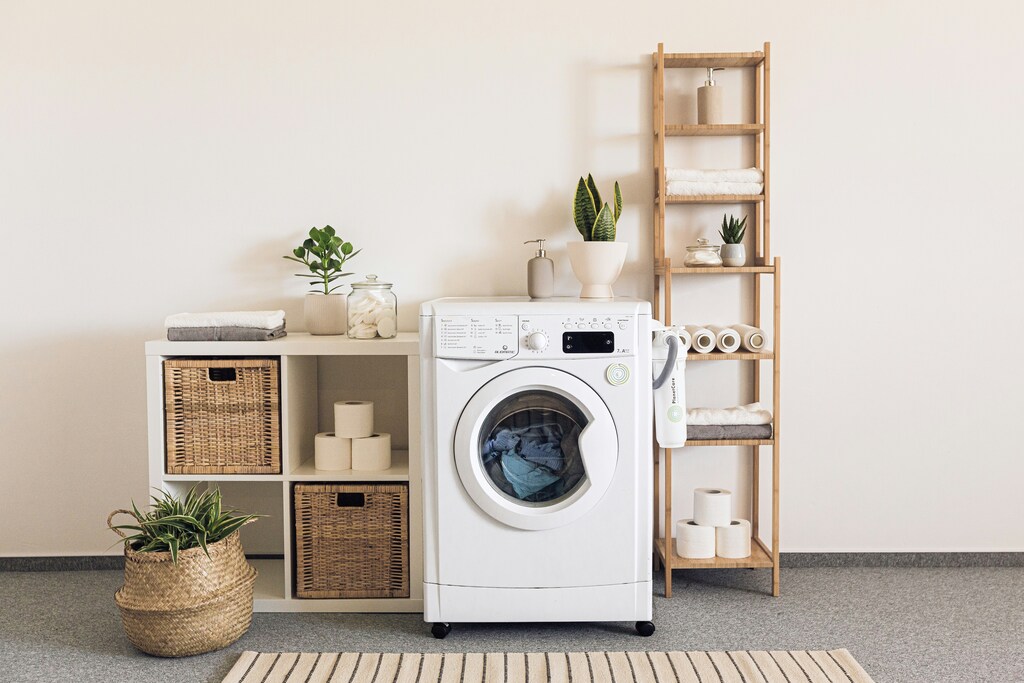Planning and building a laundry room inside shipping container homes can be very tricky. This is because a shipping container has unique features that can bring both benefits and downsides, depending on your home’s building plans.
Surprisingly, a laundry room is a space where you can add some personality to your container home. You do not necessarily need to take an “all-business” approach when designing one. In fact, you can add a bit of fun by modifying the container home laundry room to make doing laundry more enjoyable.
Designing a laundry room in a container house involves optimizing space, ensuring functionality, and maintaining a cohesive aesthetic. However, a shipping container is not very wide by default, so fitting a full laundry setup may require careful space planning. Below are plans to create a laundry room inside shipping container homes!
Can You Build a Laundry Room Inside Shipping Container Homes?
Yes, absolutely! It is entirely possible to build a laundry room inside shipping container homes. Shipping containers can be adapted to include a variety of functional spaces, including a laundry room, with some thoughtful planning. A shipping container has its drawing points that you must know before you have it, such as:
Durable
Containers are designed to withstand harsh environmental conditions and heavy usage, then they are built with highly galvanized and painted structures. This makes them less likely to get damaged by the vibrations from washing machines or dryers, and they also offer excellent protection against external forces like strong winds or minor accidents.
Eco Friendly
Using a shipping container as a laundry room is an eco-friendly option. It repurposes an old shipping container that might otherwise go to waste, giving it a second life and reducing environmental impact.
Quick Assembly
The modular nature of containers also allows for faster construction and assembly. You can set up your containers within days, making them ideal for projects with tight timelines.
Easy to Modify
Shipping containers can be easily modified with windows, doors, vents, and even plumbing systems to suit your laundry needs. Whether you need to add plumbing for a washing machine or a vent for a dryer, the container’s structure allows for flexibility in design.
Cost-Effective
Shipping containers are relatively inexpensive compared to building a traditional room or extension. If you’re looking for a quick and affordable way to add a laundry room to a property, a used shipping container is often a budget-friendly choice.
Secure Space
A shipping container offers a high level of security. The steel construction means it’s hard to break into, offering peace of mind for your laundry room, especially if you’re storing expensive appliances or cleaning supplies.
Things to Consider

Careful Planning
Most shipping containers are 20-40 feet long, so it’s important to determine how much space you want to devote to the laundry area. Depending on the size of your container, you’ll need to allocate an appropriate amount of space for the laundry room. A laundry room inside shipping container homes should accommodate a stackable washer/dryer combo and a small folding area.
During the planning process, you also need to consider the laundry room’s location. For easy access, place the laundry room near your water source, drainage, and electricity connections.
Adding Ventilation and Airflow
Add adequate ventilation in the entire container, as the laundry room can become humid, especially when washing and drying clothes. Also, buy vented dryers to properly vent the humid air. You can create a vent opening in the side of the container for the dryer exhaust or use a ventless dryer if you don’t want to cut into the metal.
Plumbing
To get a water supply, you must connect your washer to both hot and cold water lines or use a well with a pump. Other than that, you will need plumbing to make a proper drainage. If you are not on a public sewer system, you’ll need to ensure there is a wastewater disposal system, like a septic tank or greywater filtration system.
Electrical Setup
To set up the electrical wiring, you can hire a licensed electrician to ensure the wiring is up to code and safe for use. Some things in the laundry room that need electrical wiring are the washing machine, dryer, lighting, etc. Washing machines and dryers typically require a 220V connection, so be sure to have the proper electrical setup, especially if you’re relying on solar panels or a generator.
Ensure that the power supply to your washer, dryer, and any other electrical devices is functioning properly. Therefore, you need to check the cords for any signs of fraying or wear and tear.
Insulation and Comfort
Shipping containers can get hot in summer and cold in winter. Both extremes can affect the efficiency of your laundry appliances and the overall environment of your laundry room. If you live in a climate with extreme temperatures, consider adding additional insulation or using a climate control system to maintain a stable temperature. Therefore, it is a good idea to insulate the walls and floor of the laundry room by spraying foam insulation or rigid foam boards.
Furthermore, if you are sensitive to noise, add soundproofing materials around the washer and dryer to minimize vibration and noise.
Waterproofing and Floor Protection
Seal the floor and any gaps or joints properly to prevent water from leaking. You can use waterproof flooring (vinyl, tile, or rubber) to help keep moisture contained.
Container Laundry Room Maintenance
Maintaining a laundry room inside a shipping container house is crucial to ensure it remains functional, safe, and comfortable. The key is to stay on top of moisture control, prevent rust, ensure the appliances are well-maintained, and protect the container itself from the elements.
Here are some tips for maintaining your container laundry room by considering its unique characteristics:
- Prevent Moisture and Condensation: Make sure your laundry room has proper airflow, humidity level controller, and proper insulation.
- Check for Seal Gaps: Check the seals around windows, doors, and any openings for leaks. Ensure they’re well-maintained to keep moisture out and prevent rust or water damage.
- Check for Rust: Shipping containers are prone to rust, especially in areas with high humidity. If you notice rust, clean the affected areas with a wire brush, apply a rust converter, and then repaint the area with rust-resistant paint to stop it from spreading.
- Keep Floors Dry: Water pooling on the floor from washing or wet clothes can contribute to rust. Install a waterproof or rubber mat on the floor to keep it dry and protect the steel.
- Clean Your Washing Machine Regularly: This can avoid mold and unpleasant smells. Run a hot wash cycle with a washer cleaner or vinegar to clean out any buildup inside the machine.
- Check for Plumbing: Replace any old or cracked water hoses to prevent leaks. Clean the washing machine’s drain filter to avoid clogs Periodically.
- Clean the Drainage: Over time, pipes can become clogged with lint or detergent buildup. Therefore, flush the drains occasionally with hot water or a gentle drain cleaner.
- Seal Entry Points: Make sure the container’s doors, windows, and vents are sealed properly as small gaps can invite insects or rodents inside, which can be a nuisance in your laundry room.
Conclusion
With proper planning, you can create a functional, efficient, and cozy laundry room inside your shipping container house. Shipping containers can be a versatile foundation for your laundry needs. Buy shipping containers for your laundry needs at Tradecorp. Fill out this quote form, our sales will contact you and answer all your inquiries!

